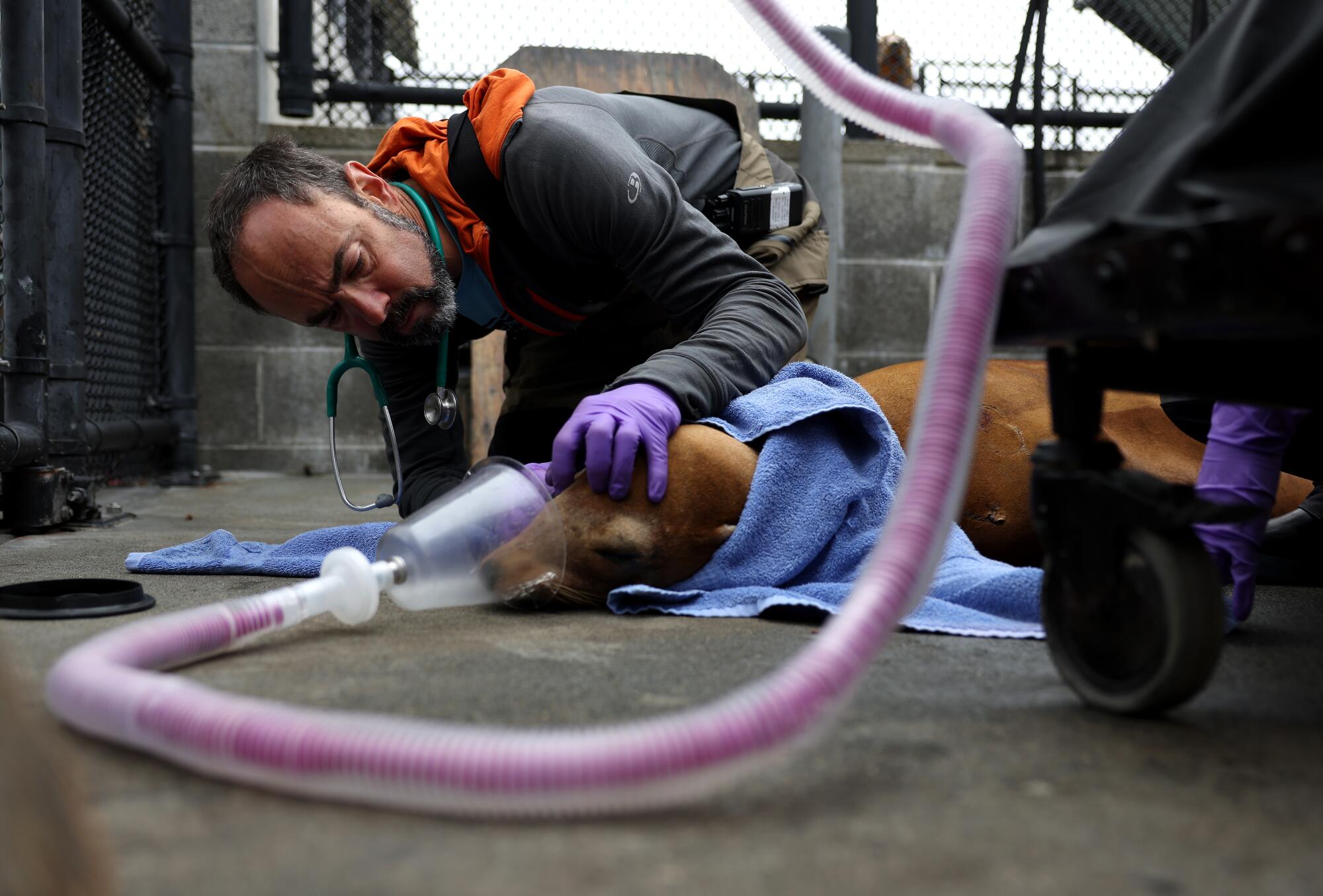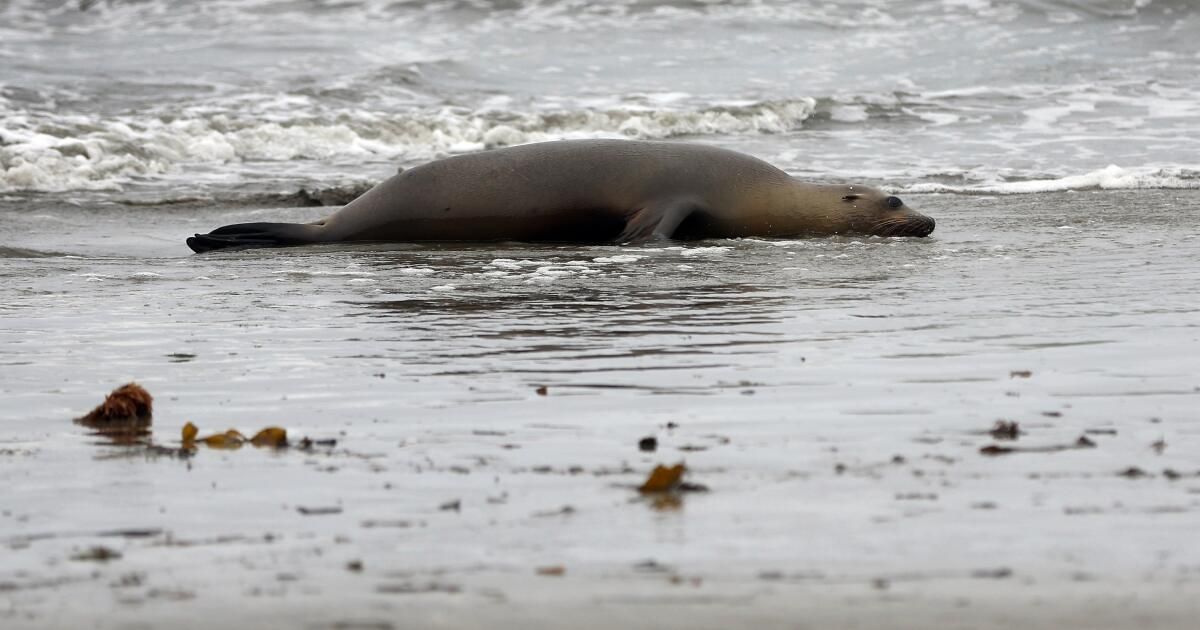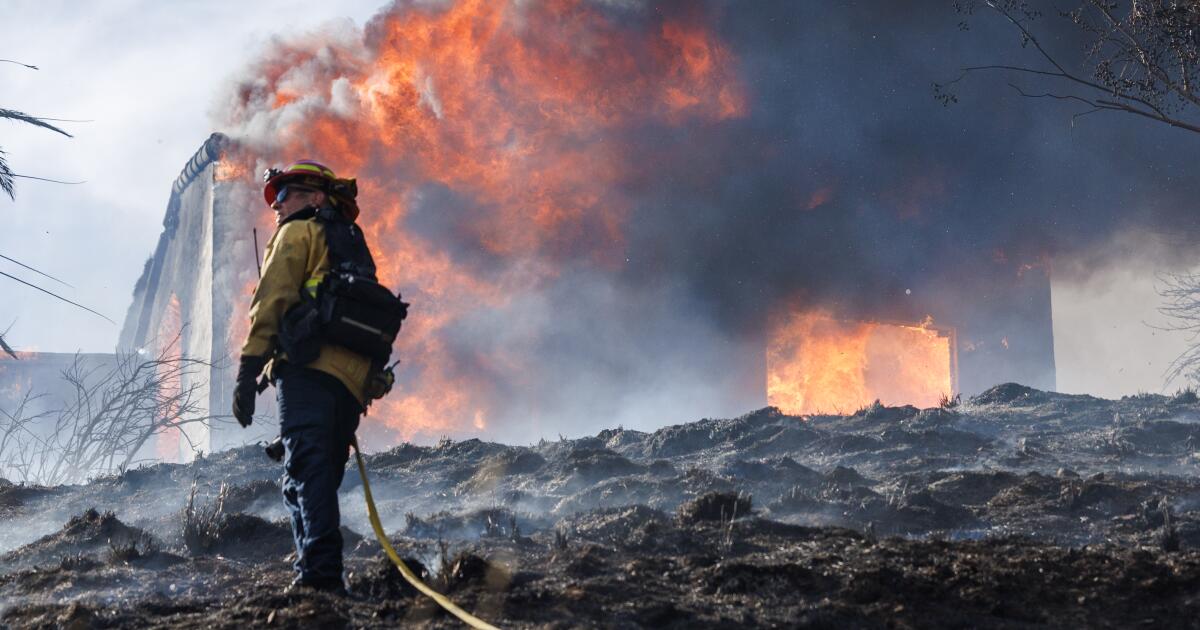By the time the rescue team reached her, a small crowd had formed around the agitated California sea lion. As the team crept closer, carrying large wooden shields and a giant net, the animal's head bobbed, stretched and swung back and forth in frenetic rhythms.
Lucille — as she was later dubbed by the Marine Mammal Center’s Morro Bay field office — barely noticed her captors approaching when the team of five animal rescue volunteers pounced on her. A minor struggle ensued as the creature’s body stiffened from convulsions, but the team eventually managed to push her into a portable XXL dog cage.
“It's really hard when they don't act like sea lions,” said Jake Roth, a 22-year-old volunteer who helped with the rescue.
It was the first of dozens of frantic rescue calls from horrified beachgoers that day, as an acute outbreak of domoic acid continued to wreak havoc on the coasts of San Luis Obispo and Santa Barbara this summer.
“The levels we’re finding inside these animals are incredible,” said Giancarlo Rulli, spokesman for the Sausalito-based Marine Mammal Center. “We’re all working.”
Domoic acid is a neurotoxin released by Pseudo-nitzschiaa common species of phytoplankton found in coastal waters. Sea lions, and other marine mammals, are poisoned when they eat large quantities of fish or invertebrates that have been feeding on contaminated diatoms.
Symptoms include lethargy, vomiting, unusual behavior, seizures, pregnancy loss, and death.
Marine Mammal Center volunteer Cris Lewis guides a sick sea lion into a box during a rescue at Cayucos State Beach.
(Justin Sullivan/Getty Images)
Phytoplankton don't always produce domoic acid, which is an amino acid. It's only made under certain conditions, which scientists are still trying to determine. But upwelling of seawater appears to be a common factor, and there's currently a strong upwelling of cold, nutrient-rich water bordering the central California coast.
The outbreak has reached crisis levels since late July.
“One of the things that has come up over and over again in a lot of our studies … is that, yes, when you have an upwelling, which is characterized by cooler water temperatures and lots of nutrients, it does stimulate a diatom bloom,” said Clarissa Anderson, director of the Southern California Coastal Ocean Observing System and the Cooperative Institute for Marine, Land and Atmospheric Systems, both of which are based at the Scripps Institution of Oceanography at the University of California, San Diego.
“But the most important question, which we haven’t been able to fully understand, is when the toxin is produced. What is the combination of conditions that requires it? Because this organism is present all the time,” he said.
Domoic acid outbreaks are not new. They have been occurring for decades, if not millennia. And although it was not identified in California waters until 1991, it is believed to have been behind previous outbreaks, including the chaotic seabird “invasion” in Capitola in 1961 that partly inspired Alfred Hitchcock’s 1963 film, “The Birds.”
What has changed, Anderson said, is the frequency, timing and location of events.
“We know that the California bloom season has always been a good time to wait for a Pseudo-nitzschia “Flowering and potentially a domoic acid event, and that can start as early as March,” he said. As a result, scientists had associated spring with domoic acid outbreaks.
“But now we are starting to see something different: these last three summers have seen intense, long and lasting blooms,” he said.
And while Monterey and Humboldt Bay had been considered classic hotspots, it is Southern California that has been hit since 2022.
He said climate change is likely playing a role in these changes, but not necessarily due to warm water temperatures.

Marine Mammal Center veterinarian Greg Frankfurter inspects a recently admitted California sea lion that was rescued from a beach showing signs of domoic acid poisoning in Sausalito.
(Justin Sullivan/Getty Images)
“One of the things we’ve seen in our years and years and years of data is that it’s the mix of nutrients that comes with the upwelling that is potentially responsible for turning the toxin on or off,” he said. “And that mix of nutrients can be affected by global climate change, because climate change is changing the physics of ocean circulation at the basin scale, like the scale of the Pacific Ocean, and that can have ramifications for what types of water, the flavor of the water, are upwelling on the California coast.”
Raphe Kudela, a professor of ocean sciences at UC Santa Cruz, said there could also be a connection with heat and runoff from inland rivers.
He said that in recent years, really wet winters have contributed to an increase in river runoff and the resulting discharge of nutrients into California's coastal waters.
“There was an upwelling impulse that brought cold water with even more nutrients to the surface and then everything warmed up. These are absolutely perfect conditions for a bloom like this,” he said.
It's also a perfect recipe for creatures like sardines and anchovies, which feed on diatoms, algae and phytoplankton in these cold, nutrient-rich waters. And those fish attract predators, like sea lions, dolphins, fur seals, birds and other fish that then feed on these “toxic bullets.”
Anderson said people occasionally ask him if they, too, could get sick from eating anchovies.
“I ask you: Do you plan to eat as many anchovies as a sea lion?” he said, noting that sea lions eat about 5% to 8% of their body weight per day. For a 150-pound person, that would be between 7.5 and 12 pounds of anchovies.
And that's part of the tragedy of this latest outbreak.
Barbie Halaska, a necropsy specialist at the Marine Mammal Center, showed visitors the milk-rich tissue surrounding the six-inch incisions she made in the chests of six of the dead sea lions that died at the Morro Bay center.
All six were adult, lactating females, he said, with thick layers of fat.
“You can see how big it is. It’s beautiful,” Halaska said, pointing to the dead but otherwise healthy-looking animal. “They have a huge food reserve. It just happens to be contaminated. When they’re nursing and they find a good food reserve, they just go and go and go. Unfortunately, that means the neurotoxin just bioaccumulates.”
She said female sea lions tend to give birth around June 15 — “we call it the sea lion’s birthday” — meaning these females likely had a dependent pup with them before they became stranded. Sea lion pups are dependent on their mothers until they are about 9 months old.
Research shows that babies raised inside contaminated pregnant females suffer brain damage. Milk from contaminated females also contains the toxin, suggesting it could be passed on to the babies.
By early afternoon, Lucille and three other sea lions were being treated for domoic acid poisoning.
Lucille was passed out and snoring on the concrete floor of the pen. Shortly after her arrival, a staff member at the facility had given her a shot of phenobarbital and midazolam in the back of her thigh to control her seizures. The staff then placed an IV bag with fluid in it to help flush the toxin from her body.
But one of the three new arrivals, a large adult female named Yippee, arrived with a broken and dislocated jaw. Staff concluded she would die if released back into the wild. They made the difficult decision to medically euthanize her.
She struggled to escape the small team that arrived to shoot her, but was eventually cornered and succumbed. Her breathing slowed and within minutes she lay motionless.
Rulli said these types of incidents are always painful and the center works hard to support staff who respond to these events. Repeated encounters with suffering animals can take a toll.
About 30 percent of the animals that came to the center in this latest outbreak, which began in late July, have died, said Aliah Meza, operations manager for the Morro Bay field office.
Farther south, where Channel Islands Marine Wildlife Institute staff are responding to the animals' plight along the coasts of Santa Barbara and Ventura, the number is more than 50 percent, said Sam Dover, founder and chief veterinarian of the Channel Islands Marine Wildlife Institute.
To keep these facilities and equipment running, both institutions rely on donations and some level of state and federal funding.
Last year, state funding was on the verge of disappearing when the governor’s office cut $2 million from the state budget. For smaller operations, like Dover’s, that would have meant a 50% cut in their operating budget. The groups succeeded in convincing lawmakers to replace the funding.
“I don’t envy the work they did with a sharp pencil and an eraser,” said Jeffrey Boehm, director of external relations for the marine center, who said he and others came to Sacramento to demonstrate that their work is in the public interest. “Having a prepared, trained and professional entity to respond to wildlife that might be having a seizure on a public beach is in the public interest. As is the science that we advance with this work … Because at the end of the day, it’s all one system.”
Lucille, who recovered from her seizures, was transported to downtown Sausalito Hospital in an air-conditioned truck the next day. She died during the transfer.
However, Veggie, another sea lion who was rescued the same day, made it to Sausalito. He is now undergoing a seven-day protocol at the hospital, where approximately 50 other sea lions are being treated.
Rulli said two sea lions were recently released into the wild at Point Reyes National Seashore, where there are no signs of an outbreak and where humpback whales are currently feeding, an indication that there is plenty of food available.
“Let’s hope they stay up here,” he said.












